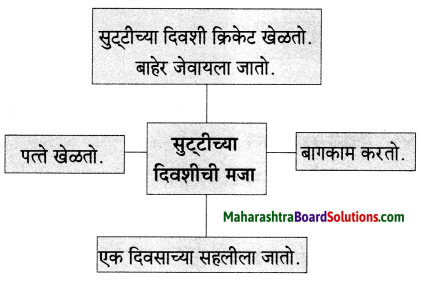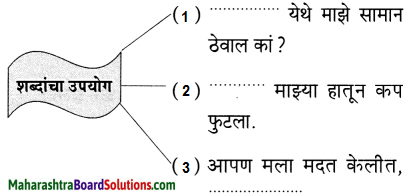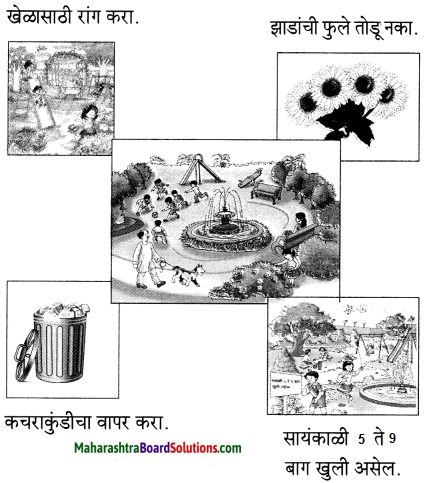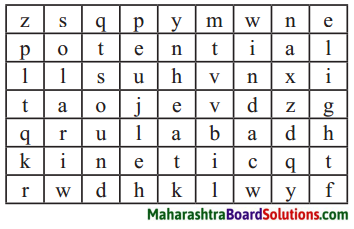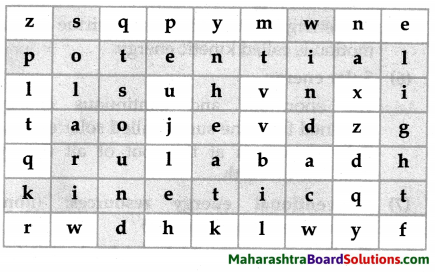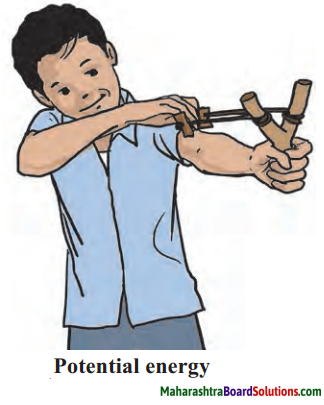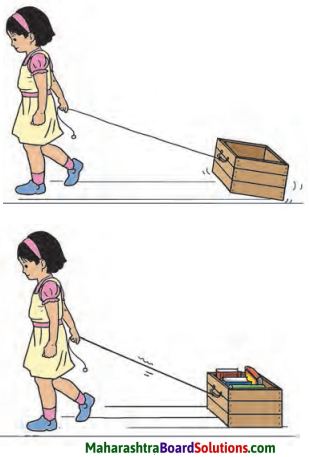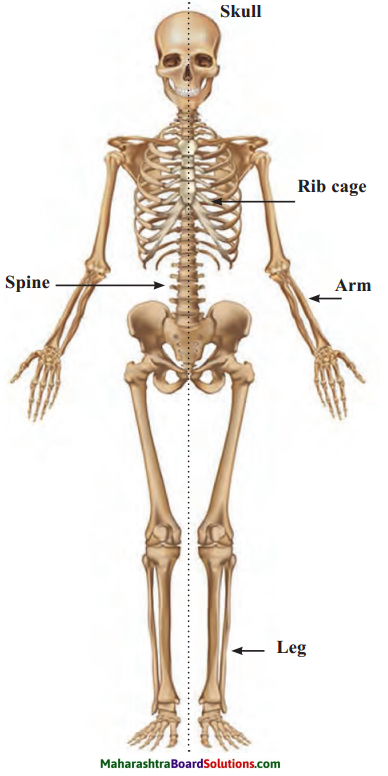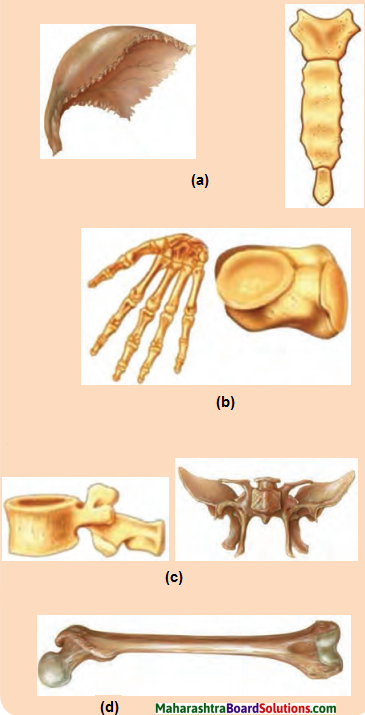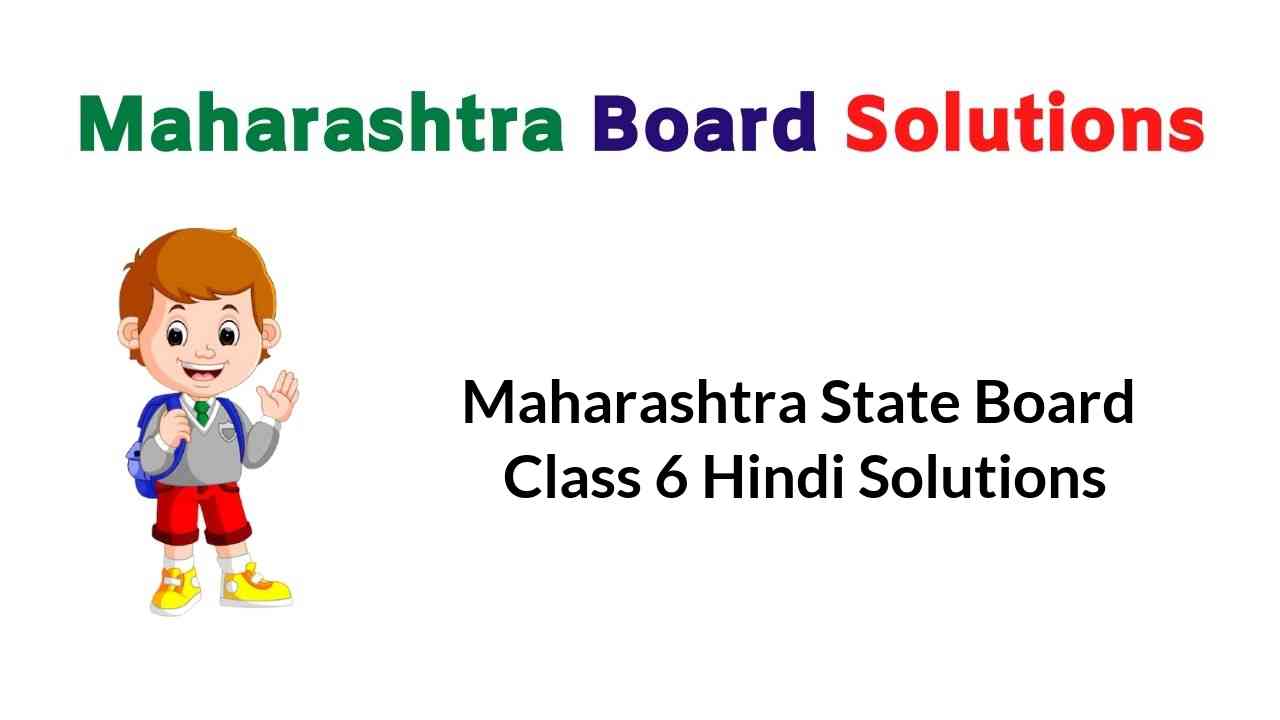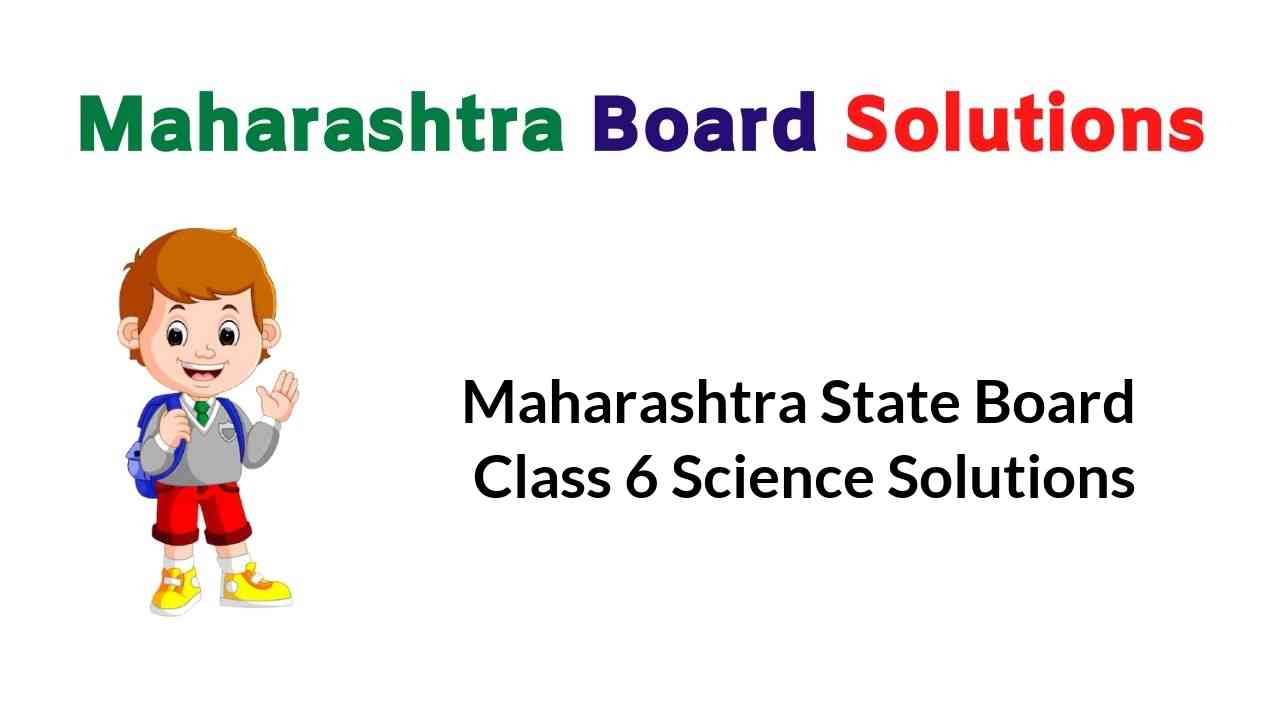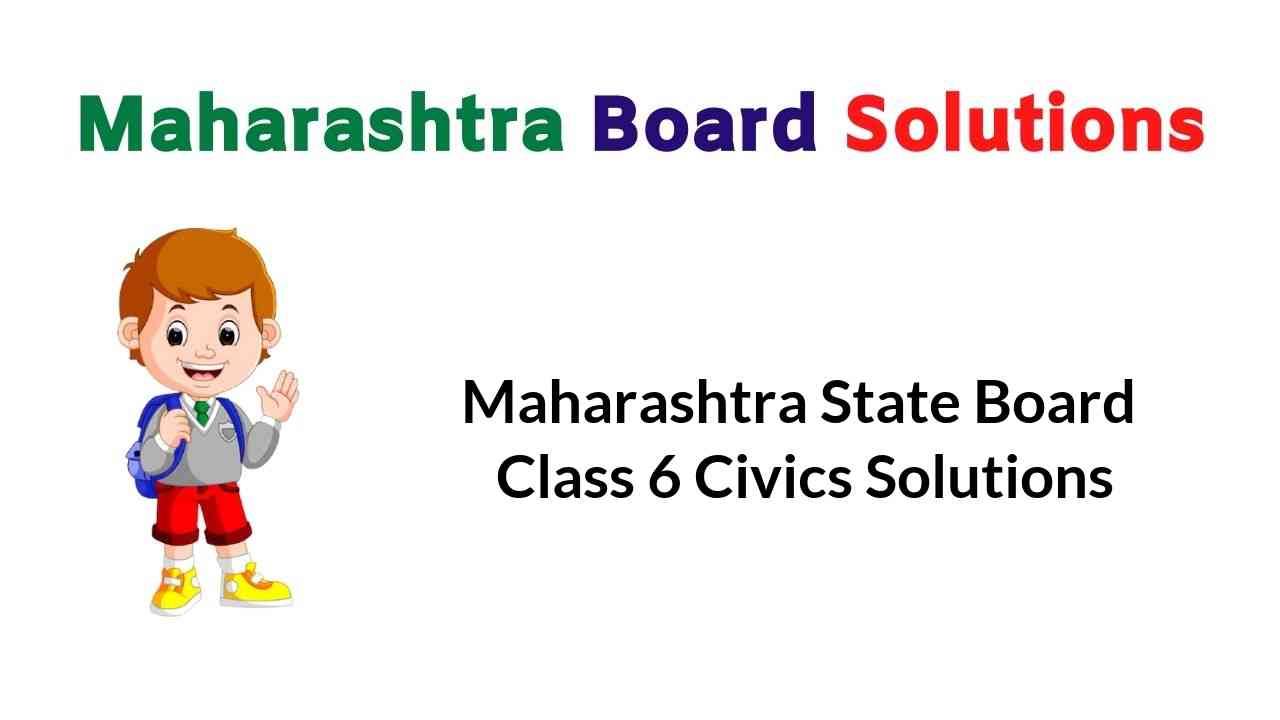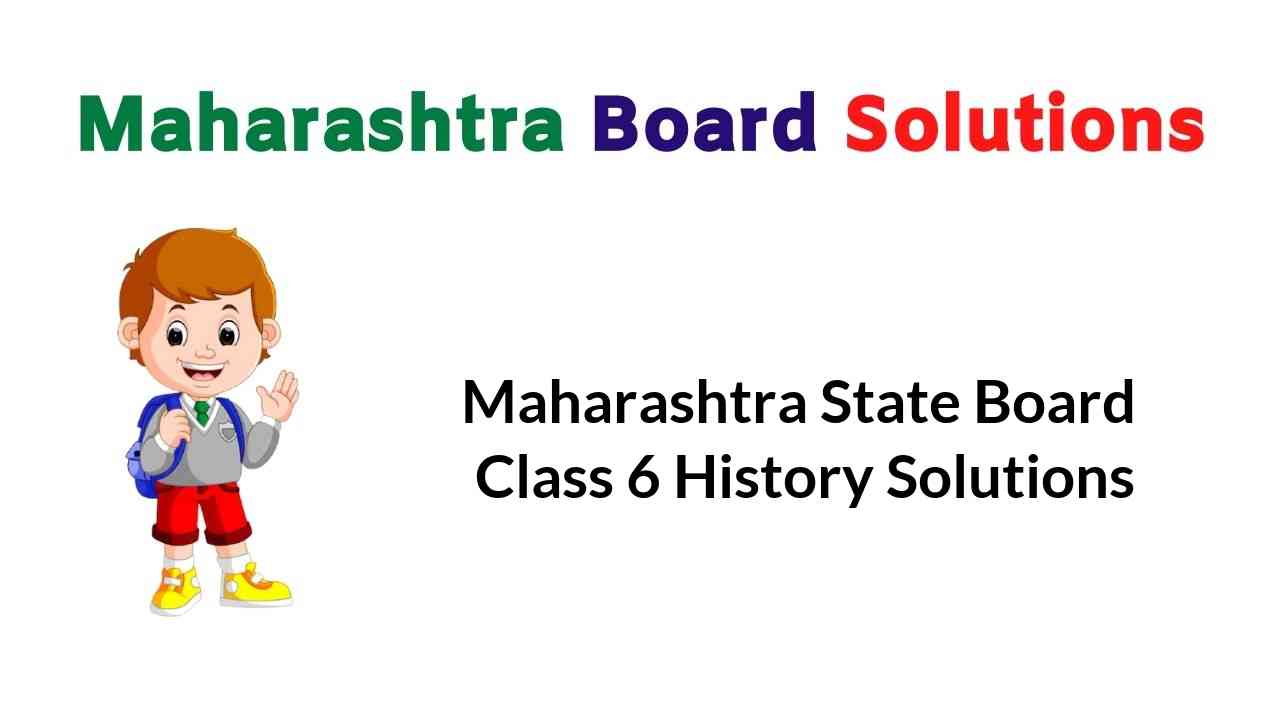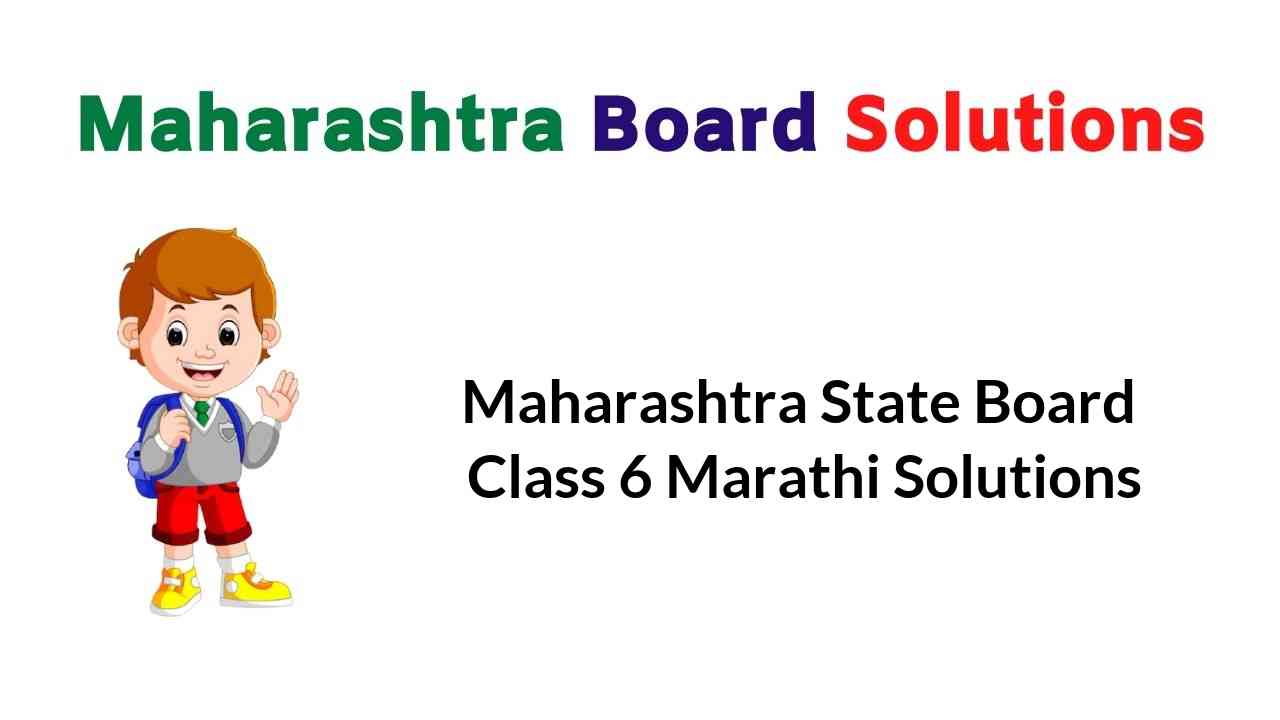Balbharti Maharashtra State Board Class 6 Science Solutions Chapter 1 Natural Resources – Air, Water and Land Notes, Textbook Exercise Important Questions and Answers.
Maharashtra State Board Class 6 Science Solutions Chapter 1 Natural Resources – Air, Water and Land
Class 6 Science Chapter 1 Natural Resources – Air, Water and Land Textbook Questions and Answers
1. Fill in the blanks and rewrite the completed statements.
Question a.
The layer of ozone gas absorbs ……………. rays that come from the sun to the earth.
Answer:
Ultraviolet (U.V) rays
Question b.
Of the total water available on the earth, fresh water forms ……….. percent.
Answer:
0.3 %
![]()
Question c.
Both …………. and ………… constituents are present in the soil.
Answer:
biotic, abiotic
2. why is it said that?
Question a.
The ozone layer is a protective shell of earth.
Answer:
- The ultra violet (UV) rays coming from the sun are very harmful for living things.
- The ozone layer present in the lower stratosphere absorb this U.V. rays and prevent them from reaching the earth. As a result life on earth is protected.
- Therefore, it is said that the ozone layer is a protective shell of the earth.
Question 2.
Water is life.
Answer:
- Water is a good solvent and it dissolves many substances.
- The human blood is made of 70% water and the sap of plant also contains a very high proportion of water.
- All the life processes would not take place in the absence of water.
- Hence, without water no living organism can survive.
- Therefore, it is said that ‘water is life’.
![]()
Question c.
Sea water is useful even though it is not potable.
OR
In what way is sea water useful even though it is salty?
Answer:
- Many fish and aquatic animals live in sea water.
- The water from the sea evaporates to form clouds which brings rain.
- The sea water also helps the land to cool due to breezes.
- The salt and minerals are also obtained from sea water.
- Corals and pearls are obtained from sea animals.
- Thus, sea water is useful even though it is not potable.
3. What will happen if
Question a.
Question a.
Microbes in soil get destroyed.
Answer:
- Microbes in the soil decompose dead plants and animals and convert it into humus. This humus supplies nutrients to the soil.
- Humus also aerates soil and holds water in it. It makes the soil more fertile.
- If microbes are destroyed, humus will not be formed and the soil will not become fertile, making it unsuitable for growth of plants. Also dead and decaying matter will accumulate on land.
Question b.
The number of vehicles and factories in your surroundings increases.
Answer:
- Vehicles and factories are the major cause of air pollution.
- They release harmful gases like carbon dioxide, carbon monoxide and sulphur dioxide into the air.
- These pollutants are harmful to the environment and to the people living in the surrounding area.
- Hence, if the number of vehicles and factories in our surroundings increases, the air pollution will also increase.
![]()
Question c.
The total supply of potable water is finished.
Answer:
- Water plays very important role in the survival of living organism.
- All living things are dependent on water.
- A very small quantity of water is potable and can be used for drinking.
- All bodily functions are regulated by water.
- Therefore, if total supply of potable water is finished, plants and animals will not survive and there will be no life on earth.
4. Match the following.
Question a.
| Group ‘A’ | Group ‘B’ |
| 1. Carbon dioxide | a. Generation of soil |
| 2. Oxygen | b. Rain |
| 3. Water vapour | c. Plants and food production |
| 4. Microbes | d. Combustion |
Answer:
| Group ‘A’ | Group ‘B’ |
| 1. Carbon dioxide | c. Plants and food production |
| 2. Oxygen | d. Combustion |
| 3. Water vapour | b. Rain |
| 4. Microbes | a. Generation of soil |
![]()
5. Name the following.
Question a.
Constituents of biosphere.
Answer:
Atmosphere, hydrosphere, lithosphere and all living things on earth.
Question b.
Biotic constituents of soil.
Answer:
Microbes, worms, insects, burrowing rhodents like rats, mice, roots of trees and plants.
Question c.
Fossil fuel.
Answer:
Crude oil from which we get kerosene, petrol, diesel, paraffin wax and tar.
Question d.
Inert gases in air.
Answer:
Neon, argon, helium, krypton, xenon.
![]()
Question e.
Gases that are harmful to ozone layer.
Answer:
Chlorofluorocarbon and carbon tetrachloride.
6. True or False?
Question a.
Land and soil is the same thing.
Answer:
False – Land consists of stones, soil and big rocks.
Question b.
The water in a lake is called ground water.
Answer:
False – Water trapped below the ground over the bedrocks is called ground water.
Question c.
It takes about thousand years to form a 25 cm thick layer of soil.
Answer:
False – It almost takes around thousand years to form a 2.5 cm thick layer of soil.
Question d.
Radon is used in decorative lights.
Answer:
False – Neon is used in decorative lights.
7. Answer in your own words.
Question a.
Explain with the help of a diagram how soil is formed.
Answer:
- The soil on the land is formed by a natural process.
- The abiotic components of soil are supplied through the weathering of the bedrock.
- Due to heat, cold wind and rain the bedrock breaks down into pieces.
- Stones, sand and soil are formed from these pieces.
- Microbes, worms, insects, rodents and roots of trees growing on land help in weathering of rocks.
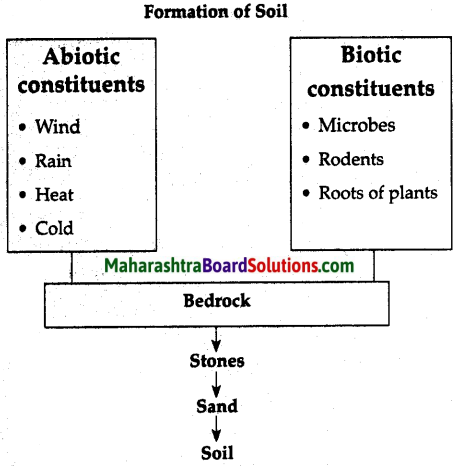
This process is slow, continuous and it takes a thousand years to form 2.5 cm thick layer of mature soil.
![]()
Question b.
Why is there a shortage of water even though it occupies about 71% of the earth’s surface?
Answer:
- 71% of earth’s surface is covered with water of, which 97% is salty water present in seas and oceans and 2.7% water is available as ground water, ice and in other forms.
- Only 0.3% water is available as fresh water which can be used for drinking.
- All the living organisms require water to drink. The water is used in the industry and also for farming.
- Due to increasing population and uncontrolled usage, we experience shortage of water.
Question c.
What are the various constituents of air? Write their uses.
Answer:
Air contains gases like oxygen, carbon dioxide, nitrogen, inert gases, water vapour and dust particles. The uses of constituents of air are as follows.
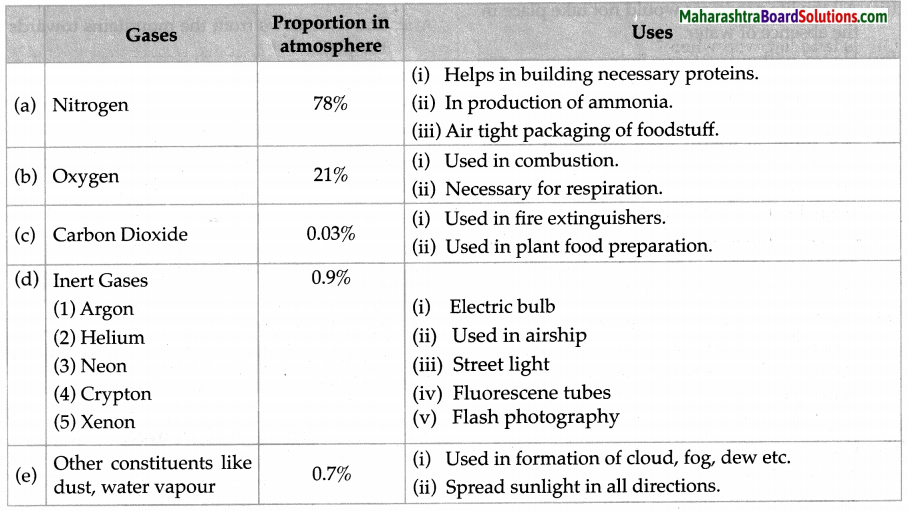
![]()
Question d.
Why are air, water and land considered to be valuable natural resources?
Answer:
- The various components of air help and support the growth of living organisms.
- Nitrogen is used to make proteins, oxygen is used for respiration and carbon dioxide is used to make food by plants.
- Similarly, land supports growth of terrestrial plants and animals. It provides important minerals to plants and also to human beings.?
- It is the shelter for worms, insects and rodents and supports their growth. Plants also cannot survive without land.
- Water is necessary for carrying out all life processes in the living organisms and without water there will be no life on earth.
- Hence land, air and water are considered valuable natural resources.
Activity:
Natural Resources Air, Water And Land Class 6 Questions And Answers Question 1.
Obtain detailed information about the work of the India Meteorological Department.
Natural Resources Air Water And Land Class 6 Questions And Answers Question 2.
Find a remedy for water scarcity.
Class 6 Science Chapter 1 Natural Resources – Air, Water and Land Important Questions and Answers
Fill in the blanks and rewrite the completed statements.
Class 6 Science Chapter 1 Natural Resources Air, Water And Land Exercise Question 1.
……………. gas, used for refrigeration and air conditioning, destroys the ozone layer.
Answer:
Chlorofluorocarbon or carbon tetrachloride
![]()
Natural Resources Air Water And Land Class 6 Exercise Question 2.
Air becomes ……………. at higher altitudes.
Answer:
rarer
Natural Resources Air Water And Land Class 6 Question 3.
………….. of land is reduced if green trees and bushes are grown in it.
Answer:
Erosion
Natural Resources Air Water And Land Question 4.
16th September is celebrated as ………. Day all over the world.
Answer:
Ozone Protection
Natural Resources Air Water And Land Question Answer Question 5.
………….. is the layer of air that surrounds the earth.
Answer:
Atmosphere
![]()
Natural Resources Air, Water And Land Question 6.
……………. occupies the largest part of the earth’s surface.
Answer:
Hydrosphere
Natural Resources Air Water And Land Class 6 Question 7.
Gases are not found in the …………… and beyond.
Answer:
exosphere
Choose the correct alternative:
Question 1.
………….. percentage of the land is covered by water.
(a) 70%
(b) 81%
(c) 71%
(d)80%.
Answer:
71%
Question 2.
The gas used in fluorescent tubes is ………………… .
(a) Argon
(b) Helium
(c) Neon
(d) Krypton.
Answer:
Krypton
![]()
Question 3.
The ozone layer is found in the lower part of …………… .
(a) atmosphere
(b) stratosphere
(c) mesosphere
(d) trophosphere.
Answer:
stratosphere
Question 4.
Gas released in air on combustion of fuel is …………….. .
(a) Hydrogen sulphide
(b) Carbon tetrachloride
(c) Nitrogen dioxide
(d) Oxygen
Answer:
Nitrogen dioxide
Question 5.
The proportion of humus in the upper layer of good fertile soil is about ……………… .
(a) 23% to 45%
(b) 33% to 50%
(c) 30% to 53%
(d) 13% to 33%
Answer:
33% to 50%
Match the following:
Question 1.
| Group ‘A’ | Group’B’ |
| 1. Argon | a. temperature for obtaining low |
| 2. Neon | b. Used in electric bulb |
| 3. Xenon | c. Decorative lights |
| 4. Chlorofluoro – carbon | d. Flash photography |
| 5. Helium | e. Ozone depletion |
Answer:
| Group ‘A’ | Group’B’ |
| 1. Argon | b. Used in electric bulb |
| 2. Neon | c. Decorative lights |
| 3. Xenon | d. Flash photography |
| 4. Chlorofluoro – carbon | e. Ozone depletion |
| 5. Helium | a. temperature for obtaining low |
![]()
Name the following:
Question 1.
Substances formed when fuel burns.
Answer:
Carbon dioxide, carbon monoxide, nitrogen dioxide, sulphur dioxide and smoke.
Question 2.
Layers of the atmosphere.
Answer:
Troposphere, stratosphere, mesosphere, ionosphere and exosphere.
Question 3.
Layers of land.
Answer:
Humus, mature soil, immature soil, small rocks and stones and bedrock.
![]()
Question 4.
Gas necessary for building proteins.
Answer:
Nitrogen.
State whether True or False. Correct if False.
Question 1.
The amount of gases in the air is greatest near the surface and becomes rarer at higher altitudes.
Answer:
True.
Question 2.
Fogs, clouds, snow, and rain are produced in the exosphere.
Answer:
False – Fogs, clouds, snow and rain are formed in the troposphere and lower stratosphere of the atmosphere.
Question 3.
Fossil fuels are formed from the dead remains of animals and plants buried underground for a long period.
Answer:
True.
Explain what will happen if:
Question 1.
Forests are destroyed.
Answer:
- Soil will get eroded due to rains as roots of trees hold the soil.
- The land will become barren as trees helps to increase the level of ground water.
- Amount of carbondioxide in the air will increase as trees use carbondioxide for photosynthesis and release oxygen.
- Natural habitat of many animals will get completely destroyed.
![]()
Question 2.
What would have happened if there was no air on the earth?
Answer:
- Air contains gases like nitrogen, oxygen, carbon dioxide, dust particles and water vapour, which are used in various piofeesses in living organisms and environment.
- If there is no air then there will be no life as oxygen is essential for all living beings to survive. Also atmosphere is a very important filter. It prevents die harmful elements from reaching the earth.
- Hence without air, our earth would become a cold, dark planet without any life.
Answer the following:
Question 1.
What is humus?
Answer:
Humus is the topmost layer of the soil formed d by decomposition of remains of plants and animals and it makes the soil fertile.
Question 2.
What is land made up of?
Answer:
Land is made up of stones, soil, sand and big rocks.
![]()
Question 3.
Is land flat everywhere?
Answer:
No, land is not flat everywhere. It is flat in some regions and hilly in some regions.
Question 4.
Does man produce soil/ land?
Answer:
No, man does not produce soil/land, it is produced naturally.
Question 5.
What do you see on land?
Answer:
We see mountains, rivers, valleys, ocean, also terrestrial animals and plants. We also see roads, bridges, buildings etc.
Question 6.
What has man created on land?
Answer:
Man has dug wells, borewells to lift ground water. He has also constructed bunds and dams. He has also built many industries, buildings, roads for transport.
![]()
Question 7.
If a deep pit is dug in the ground, what do you see there?
Answer:
We see different layers of land.
Answer in your own words.
Question 1.
Explain with the help of diagram various layers of land.
Answer:
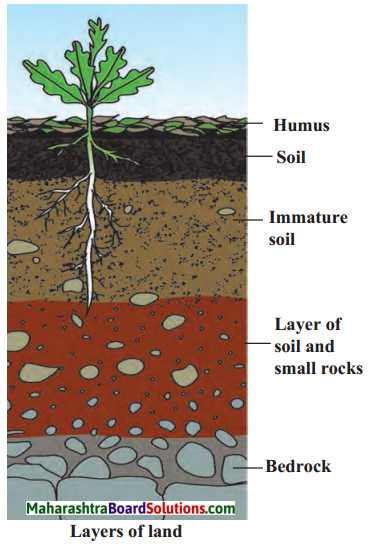
- Humus – Topmost layer, fertile layer formed by decomposition of remains of plants and animals. Immature
- Soil – Sand, soil, small stones, worms and insects.
- Layer of soil and small rocks – less soil and more rocks.
- Bedrocks – main minerals are obtained from this layer, determines colour and texture of soil.
Observe the picture and answer the questions.
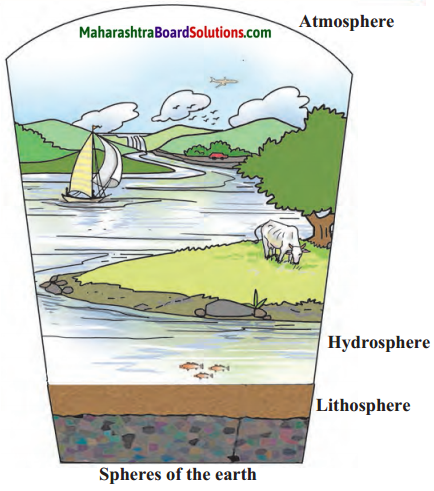
Question 1.
Where do you see the birds?
Answer:
The birds are flying in the sky.
![]()
Question 2.
Where is the cow grazing?
Answer:
The cow is grazing in the pasture (field).
Question 3.
Locate the trees.
Answer:
The trees are seen along the river bank.
Question 4.
Where does the river come from?
Answer:
The river flows from the mountains towards the plains.
Question 5.
Where is the aeroplane?
Answer:
The aeroplane is in the sky above the clouds.
![]()
Question 6.
Where are fishes seen?
Answer:
Fishes are seen swimming in the river water.
Question 7.
On what is the sail boat floating?
Answer:
Sail boat is floating on the water.
Observe and discuss:

Question 1.
What is the similarity in the three pictures given above?
Answer:
All the pictures given above show large scale emission of smoke through different agencies. This smoke directly mixes with the atmosphere, disturbing the balance between the constituents of air and causing air pollution.
Observe and discuss:
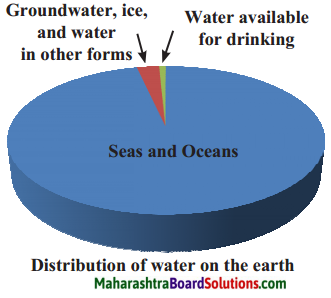
Observe the distribution of water on the earth surface and complete the table.
Question 1.
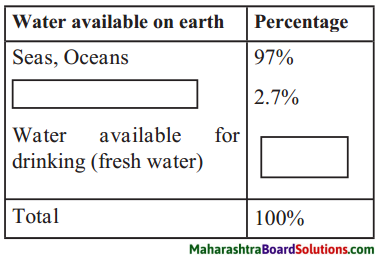
Answer:
| Water available on earth | percentage |
| Seas, oceans | 97% |
| Groundwater and water in other forms | 2.7% |
| Water available for drinking | 0.3% |
| Total | 100% |
Observe given figure carefully and answer the following.
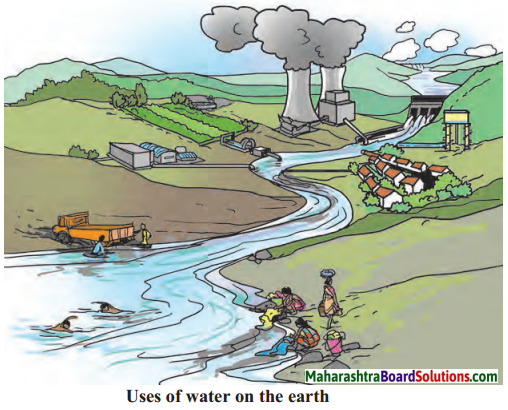
Question 1.
For which purpose is water being used?
Answer:
Water is being used for washing clothes, for bathing, farming, drinking, and industries.
![]()
Question 2.
Do other living things use water like we do?
Answer:
Animals do not use water like us. They use water only for drinking. Some animals like buffaloes, rhinoceros, elephants use water for cooling themselves during summers.
Question 3.
What are the constituents of soil? Classify them as biotic and abiotic constituents.
Answer:
The constituents of soil are humus, soil, sand, gravel, stones, bedrock, insects, worms, microbes, roots of trees and dead leaves, burrowing rodents like mice and rats.
| Biotic | Abiotic |
| Microbes, rodents like mice and rats, humus containing microbes and dead leaves. | Soil, sand, gravel, stones, bedrock. |
Answer the following:
Question 1.
How would you save water? Give some measures you will adopt.
Answer:
Water can be saved in the following ways:
- Repair the leaking taps and pipes and prevent wastage of water.
- Take water in a bucket to wash a car, rather than using a hose pipe.
- Close the tap when not required.
- Store rainwater in underground tanks so that it can be used all round the year.
- Water leftover after washing vegetables etc. can be used for watering plants in the garden.
- Use water sparingly and reuse water wherever possible.
![]()
Question 2.
What measures would you take to prevent soil erosion?
Answer:
- The trees, bushes and grass shall be planted in open spaces.
- Shrubs will be planted along the river banks to prevent floods.
- Proper drainage system will be provided so that there is no flooding of water.
Let’s try this
- Take a transparent plastic bottle, a handful of soil, big stones, small stones, sand, some dry leaves and water.
- Cut off the upper tapering part of the bottle. Put the rest of the materials in the lower part and add water.
- Stir the mixture thoroughly and put it aside.
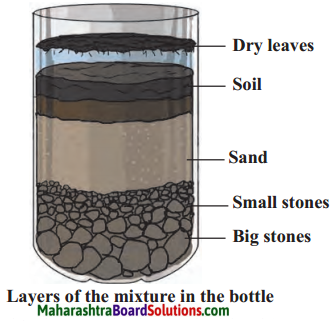
Observe it the next day and answer.
Question 1.
How does the mixture in the bottle look now?
Answer:
The mixture gets segregated into various layers. Heaviest substances settle down and lighter forms topmost layer.
Question 2.
Do you see the layers in it?
Answer:
Yes, we see the layers of soil.
![]()
Question 3.
What is seen in the different layers from top to bottom?
Answer:
The dry leaves are floating above the water at the top. Then the layer of the soil, which forms a layer above the sand. Below the sand we see a layer of small stones, and the big ones have settled down at the bottom of the bottle.
Question 4.
Obtain specimens of soil from various places and note the differences in the specimen with respect to colour, feel, texture and size of the particles.
Answer:
| Area from where soil sample is taken | Colour | Texture |
| 1. Own yard | Red colour | Smooth soil which is dry. |
| 2. Garden | Black colour | Sticky soil, rich in humus and insects. |
| 3. Hills | Red colour | Rough soil with small stones and pebbles. |
| 4. River banks | White colour | Sandy and moist in nature. |
| 5. Fields | Black soil | Sticky soil with fine particles, rich in humus and worms. |
| 6. Rocky ground | Black | Coarse with stones and pebbles, hardly any fine soil is seen. |
![]()
Question 5.
Observe how much water is used and for what purposes it is used in your house for a whole day. Record it in a chart. Discuss this data and find out how much water each person needs in your house.
Answer:
| Purpose for which water is used | Amount of water (approx in litres) |
| 1. Bath | 50 litres |
| 2. Brushing teeth | 1 litre |
| 3. Washing clothes and utensils | 75 litres |
| 4. Mopping the floor | 10 litres |
| 5. Drinking | 8 litres |
| 6. Cooking | 6 litres |
| Total use of water | 150 litres |
Total number of persons = 3
Total water used per person = \(\frac{50}{3}\) = 50 litres.
Approximately 50 litres of water is required for 1 person.
![]()
